J. Subramani , G. Kumarapandiyan
Department of Statistics, Ramanujan School of Mathematical Sciences, Pondicherry University, R V Nagar, Kalapet, 605014, Puducherry
Correspondence to: J. Subramani , Department of Statistics, Ramanujan School of Mathematical Sciences, Pondicherry University, R V Nagar, Kalapet, 605014, Puducherry.
| Email: |  |
Copyright © 2012 Scientific & Academic Publishing. All Rights Reserved.
Abstract
The present paper deals with a class of modified ratio estimators for estimation of population mean of the study variable using the linear combination of the known values of the Co-efficient of Variation and the Median of the auxiliary variable. The biases and the mean squared errors of the proposed estimators are derived and are compared with that of existing modified ratio estimators. Further we have also derived the conditions for which the proposed estimators perform better than the existing modified ratio estimators. The performances of the proposed estimators are also assessed with that of the existing estimators for certain natural populations. From the numerical study it is observed that the proposed modified ratio estimators perform better than the existing modified ratio estimators.
Keywords:
Mean Squared Error, Modified Ratio Estimators, Natural Populations, Simple Random Sampling
Cite this paper:
J. Subramani , G. Kumarapandiyan , "Estimation of Population Mean Using Co-Efficient of Variation and Median of an Auxiliary Variable", International Journal of Probability and Statistics , Vol. 1 No. 4, 2012, pp. 111-118. doi: 10.5923/j.ijps.20120104.04.
1. Introduction
The simplest estimator of population mean is the sample mean obtained by using simple random sampling without replacement, when there is no additional information on the auxiliary variable available. Sometimes in sample surveys, along with the study variable Y , information on auxiliary variable X, correlated with Y , is also collected. This information on auxiliary variable X, may be utilized to obtain a more efficient estimator of the population mean. Ratio method of estimation is an attempt in this direction. This method of estimation may be used when (i) X represents the same character as Y, but measured at some previous date when a complete count of the population was made and (ii) the character X is cheaply, quickly and easily available. Consider a finite population  of N distinct and identifiable units. Let Y is a study variable with value Yi measured on
of N distinct and identifiable units. Let Y is a study variable with value Yi measured on  giving a vector
giving a vector and let X is an auxiliary variable which is readily available. The problem is to estimate the population mean
and let X is an auxiliary variable which is readily available. The problem is to estimate the population mean  with some desirable properties on the basis of a random sample selected from the population U using auxiliary information. When the population parameters of the auxiliary variable X such as Population Mean, Co-efficient of Variation, Co-efficient of Kurtosis, Co-efficient of Skewness, Median are known, a number of estimators such as ratio, product and linear regression estimators and their modifications are proposed in the literature. Before discussing further about the modified ratio estimators and the proposed modified ratio estimators the notations to be used in this paper are described below:
with some desirable properties on the basis of a random sample selected from the population U using auxiliary information. When the population parameters of the auxiliary variable X such as Population Mean, Co-efficient of Variation, Co-efficient of Kurtosis, Co-efficient of Skewness, Median are known, a number of estimators such as ratio, product and linear regression estimators and their modifications are proposed in the literature. Before discussing further about the modified ratio estimators and the proposed modified ratio estimators the notations to be used in this paper are described below: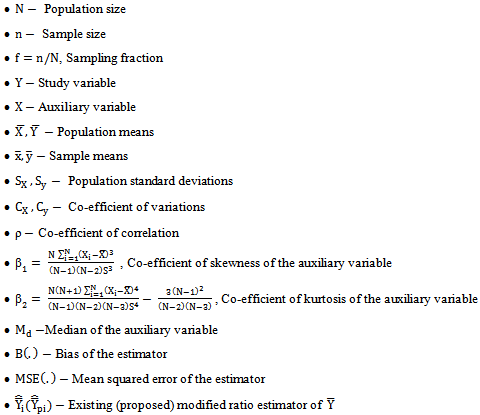 The Ratio estimator for estimating the population mean
The Ratio estimator for estimating the population mean  of the study variable Y is defined as
of the study variable Y is defined as | (1) |
It is to be noted that “the existing modified ratio estimators” means the list of modified ratio estimators to be considered in this paper unless otherwise stated. It does not mean to the entire list of modified ratio estimators available in the literature. For a more detailed discussion on the ratio estimator and its modifications one may refer to Cochran[1], Kadilar and Cingi[2,3], Koyuncu and Kadilar[4], Murthy[5], Prasad[6], Rao[7], Singh and Tailor[9, 11], Singh et.al[10], Sisodia and Dwivedi[12], Subramani and Kumarapandiyan [13,14,15,16,17], Upadhyaya and Singh[18], Yan and Tian[19] and the references cited there in.The modified ratio estimators given in Table 1 and Table 2 are biased but have minimum mean squared errors compared to the classical ratio estimator. The list of estimators given in Table 1 and Table 2 uses the known values of the parameters like  and their linear combinations. However, it seems, no attempt is made to use the linear combination of known values of the Co-efficient of variation and Median of the auxiliary variable to improve the ratio estimator. The points discussed above have motivated us to introduce modified ratio estimators using the linear combination of the known values of Co-efficient of variation and Median of the auxiliary variable. It is observed that the proposed estimators perform better than the existing modified ratio estimators listed in Table 1 and Table 2.
and their linear combinations. However, it seems, no attempt is made to use the linear combination of known values of the Co-efficient of variation and Median of the auxiliary variable to improve the ratio estimator. The points discussed above have motivated us to introduce modified ratio estimators using the linear combination of the known values of Co-efficient of variation and Median of the auxiliary variable. It is observed that the proposed estimators perform better than the existing modified ratio estimators listed in Table 1 and Table 2. Table 1. Existing modified ratio estimators (Class 1) with their biases, mean squared errors and their constants
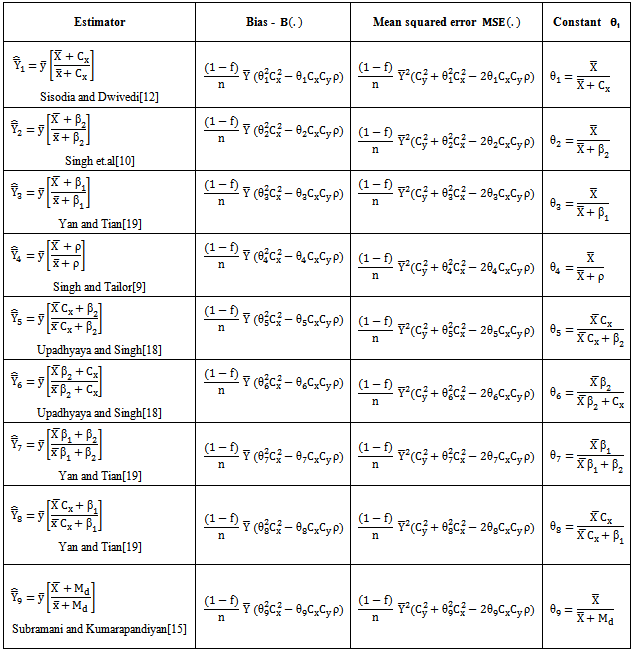 |
| |
|
Table 2. Existing modified ratio estimators (Class 2) with their biases, mean squared errors and their constants
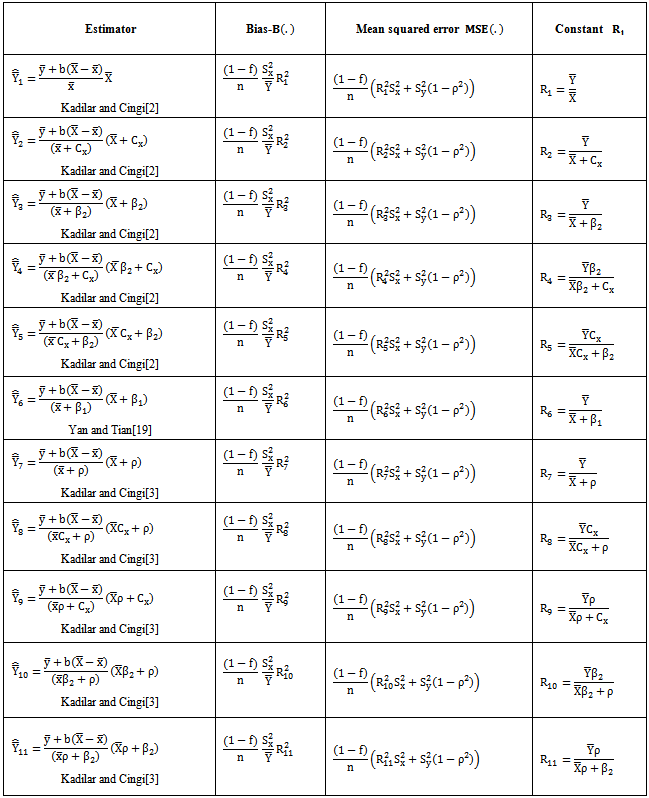 |
| |
|
2. Proposed Modified Ratio Estimators
In this section, we have suggested a class of modified ratio estimators using the linear combination of Co-efficient of variation and Median of the auxiliary variable. The proposed modified ratio estimators for estimating the population mean  together with the first degree of approximation, the biases and mean squared errors and the constants are given below:
together with the first degree of approximation, the biases and mean squared errors and the constants are given below:Table 3. Proposed modified ratio estimators with their biases, mean squared errors and their constants
 |
| |
|
3. Efficiency Comparison
For want of space; for the sake of convenience to the readers and for the ease of comparisons, the modified ratio estimators given in Table 1, Table 2 are represented into two classes as given below: Class 1: The biases, the mean squared errors and the constants of the modified ratio type estimators  listed in the Table 1 are represented in a single class (say, Class 1), which will be very much useful for comparing with that of proposed modified ratio estimators and are given below:
listed in the Table 1 are represented in a single class (say, Class 1), which will be very much useful for comparing with that of proposed modified ratio estimators and are given below: | (2) |
 Class 2: The biases, the mean squared errors and the constants of the 11 modified ratio estimators
Class 2: The biases, the mean squared errors and the constants of the 11 modified ratio estimators  listed in the Table 2 are represented in a single class (say, Class 2), which will be very much useful for comparing with that of proposed modified ratio estimators and are given below:
listed in the Table 2 are represented in a single class (say, Class 2), which will be very much useful for comparing with that of proposed modified ratio estimators and are given below: | (3) |
 As derived earlier in section 2, the biases, the mean squared errors and the constants of the proposed modified ratio estimators are given below:
As derived earlier in section 2, the biases, the mean squared errors and the constants of the proposed modified ratio estimators are given below: | (4) |
 | (5) |
 | (6) |
From the expressions given in (2) and (4) we have derived the conditions for which the proposed estimator  is more efficient than the existing modified ratio estimators given in Class 1,
is more efficient than the existing modified ratio estimators given in Class 1,  and are given below:
and are given below: | (7) |
From the expressions given in (5), (6) and (4) we have derived the conditions for which the proposed estimator  is more efficient than the existing modified ratio estimators given in Class 2,
is more efficient than the existing modified ratio estimators given in Class 2,  and are given below:
and are given below: | (8) |
4. Numerical Study
The performances of the proposed modified ratio estimators listed in Table 3 are assessed with that of existing modified ratio estimators listed in Table 1 and Table 2 for certain natural populations. In this connection, we have considered three natural populations for the assessment of the performances of the proposed modified ratio estimators with that of existing modified ratio estimators. The population 1 and population 2 are taken from Singh and Chaudhary[8] given in page 177 and population 3 is taken from Murthy[5] given in page 228. The population parameters and the constants computed from the above populations are given below: The constants, biases and mean squared errors of the existing and proposed modified ratio estimators for the above populations are given from Table 5 to Table 10:Table 4. Parameters and Constants of the Populations
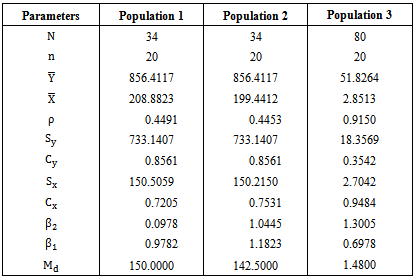 |
| |
|
Table 5. The constants of the (Class 1) existing and proposed modified ratio estimators
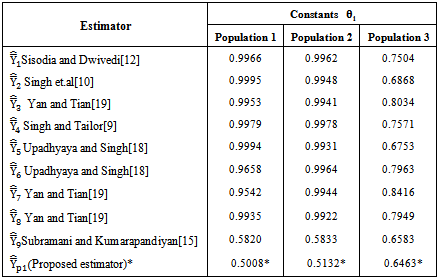 |
| |
|
Table 6. The constants of the (Class 2) existing and proposed modified ratio estimators
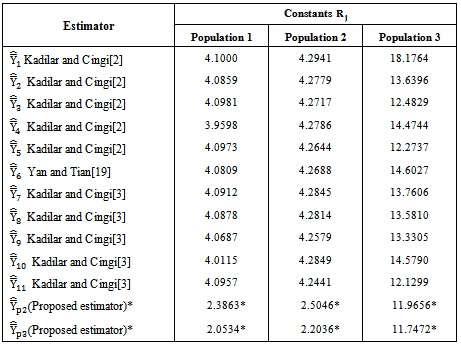 |
| |
|
Table 7. The biases of the (Class 1) existing and proposed modified ratio estimators
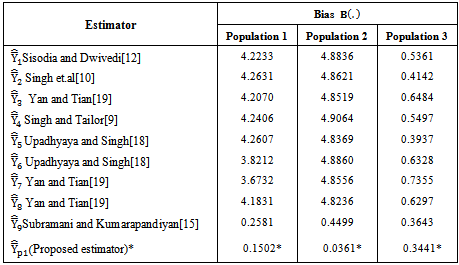 |
| |
|
Table 8. The biases of the (Class 2) existing and proposed modified ratio estimators
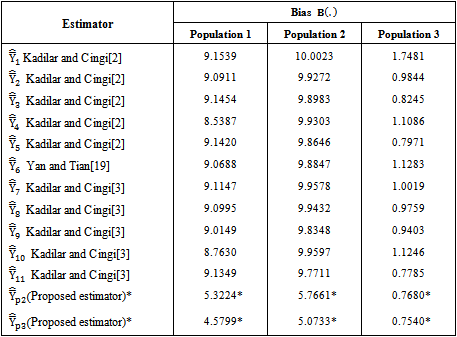 |
| |
|
Table 9. The mean squared errors of the (Class 1) existing and proposed modified ratio estimators
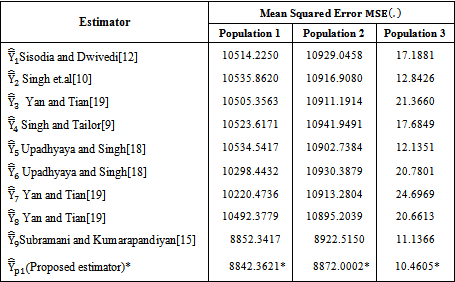 |
| |
|
Table 10. The mean squared errors of the (Class 2) existing and proposed modified ratio estimators
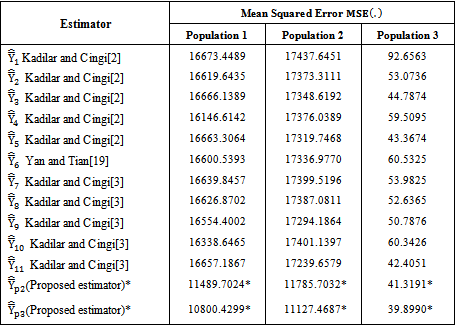 |
| |
|
From the values of Table 7 and Table 8, it is observed that the bias of the proposed modified ratio estimator  is less than the biases of the (Class 1) existing modified ratio estimators
is less than the biases of the (Class 1) existing modified ratio estimators  and the biases of the proposed modified ratio estimators
and the biases of the proposed modified ratio estimators  are less than the biases of the (Class 2) existing modified ratio estimators
are less than the biases of the (Class 2) existing modified ratio estimators  . Similarly from the values of Table 9 and Table 10, it is observed that the mean squared error of the proposed modified ratio estimator
. Similarly from the values of Table 9 and Table 10, it is observed that the mean squared error of the proposed modified ratio estimator  is less than the mean squared errors of the (Class 1) existing modified ratio estimators
is less than the mean squared errors of the (Class 1) existing modified ratio estimators  and the mean squared errors of the proposed modified ratio estimators
and the mean squared errors of the proposed modified ratio estimators  are less than the mean squared errors of the (Class 2) existing modified ratio estimators
are less than the mean squared errors of the (Class 2) existing modified ratio estimators  .
.
5. Conclusions
The existing modified ratio estimators with the known values of the parameters like  are biased but have minimum mean squared errors compared to the classical ratio estimator. In this paper, we use the linear combination of known values of the Co-efficient of variation and Median of the auxiliary variable to improve the ratio estimator. The biases and mean squared errors of the proposed estimators are obtained. Further we have derived the conditions for which the proposed estimators are more efficient than the existing modified ratio estimators. We have also assessed the performances of the proposed estimators for some known populations given in the text books [5] and [8]. It is observed that the biases and mean squared errors of the proposed estimators are less than the biases and mean squared errors of the existing modified ratio estimators. Hence we strongly recommend that the proposed modified estimators may be preferred over the existing modified ratio estimators for the use in practical applications.
are biased but have minimum mean squared errors compared to the classical ratio estimator. In this paper, we use the linear combination of known values of the Co-efficient of variation and Median of the auxiliary variable to improve the ratio estimator. The biases and mean squared errors of the proposed estimators are obtained. Further we have derived the conditions for which the proposed estimators are more efficient than the existing modified ratio estimators. We have also assessed the performances of the proposed estimators for some known populations given in the text books [5] and [8]. It is observed that the biases and mean squared errors of the proposed estimators are less than the biases and mean squared errors of the existing modified ratio estimators. Hence we strongly recommend that the proposed modified estimators may be preferred over the existing modified ratio estimators for the use in practical applications.
ACKNOWLEDGEMENTS
The second author wishes to record his gratitude and sincere thanks to the Vice Chancellor, Pondicherry University and other University authorities for having given the financial assistance to carry out this research work through the University Fellowship.
References
| [1] | Cochran, W. G. (1977). Sampling techniques, Third Edition, Wiley Eastern Limited] |
| [2] | Kadilar, C. and Cingi, H. (2004): Ratio estimators in simple random sampling, Applied Mathematics and Computation 151, 893-902 |
| [3] | Kadilar, C. and Cingi, H. (2006): An improvement in estimating the population mean by using the correlation co-efficient, Hacettepe Journal of Mathematics and Statistics Volume 35 (1), 103-109 |
| [4] | Koyuncu, N. and Kadilar, C. (2009): Efficient Estimators for the Population mean, Hacettepe Journal of Mathematics and Statistics, Volume 38(2), 217-225 |
| [5] | Murthy, M.N. (1967): Sampling theory and methods, Statistical Publishing Society, Calcutta, India |
| [6] | Prasad, B. (1989): Some improved ratio type estimators of population mean and ratio in finite population sample surveys, Communications in Statistics: Theory and Methods 18, 379–392, |
| [7] | Rao, T.J. (1991): On certain methods of improving ratio and regression estimators, Communications in Statistics: Theory and Methods 20 (10), 3325–3340 |
| [8] | Singh, D. and Chaudhary, F.S. (1986): Theory and Analysis of Sample Survey Designs, New Age International Publisher |
| [9] | Singh, H.P. and Tailor, R. (2003): Use of known correlation co-efficient in estimating the finite population means, Statistics in Transition 6 (4), 555-560 |
| [10] | Singh, H.P., Tailor, R., Tailor, R. and Kakran, M.S. (2004): An improved estimator of population mean using power transformation, Journal of the Indian Society of Agricultural Statistics 58(2), 223-230 |
| [11] | Singh, H.P. and Tailor, R. (2005): Estimation of finite population mean with known co- efficient of variation of an auxiliary, STATISTICA, anno LXV, n.3, pp 301-313 |
| [12] | Sisodia, B.V.S. and Dwivedi, V.K. (1981): A modified ratio estimator using co-efficient of variation of auxiliary variable, Journal of the Indian Society of Agricultural Statistics 33(1), 13-18 |
| [13] | Subramani, J. and Kumarapandiyan, G. (2012): A class of almost unbiased modified ratio estimators for population mean with known population parameters, Elixir Statistics 44, 7411-7415 |
| [14] | Subramani, J. and Kumarapandiyan, G. (2012): Almost unbiased modified linear regression estimators for estimation of population mean, Bonfring International Journal of Industrial Engineering and Management Science, Vol. 2(2), 24-27 |
| [15] | Subramani, J. and Kumarapandiyan, G. (2012): Modified ratio estimator for population mean using median of the auxiliary variable, Submitted for Publication. |
| [16] | Subramani, J. and Kumarapandiyan, G. (2012): Modified ratio estimators for population mean using function of quartiles of auxiliary variable, Bonfring International Journal of Industrial Engineering and Management Science, Vol. 2(2), 19-23 |
| [17] | Subramani, J. and Kumarapandiyan, G. (2012): Modified ratio estimators using known median and co-efficient of kurtosis, American Journal of Mathematics and Statistics, Vol. 2(4), 95-100 |
| [18] | Upadhyaya, L.N. and Singh, H.P. (1999): Use of transformed auxiliary variable in estimating the finite population mean, Biometrical Journal 41 (5), 627-636 |
| [19] | Yan, Z. and Tian, B. (2010): Ratio method to the mean estimation using co-efficient of skewness of auxiliary variable, ICICA , Part II, CCIS 106, pp. 103–110 |

 of N distinct and identifiable units. Let Y is a study variable with value Yi measured on
of N distinct and identifiable units. Let Y is a study variable with value Yi measured on  giving a vector
giving a vector and let X is an auxiliary variable which is readily available. The problem is to estimate the population mean
and let X is an auxiliary variable which is readily available. The problem is to estimate the population mean  with some desirable properties on the basis of a random sample selected from the population U using auxiliary information. When the population parameters of the auxiliary variable X such as Population Mean, Co-efficient of Variation, Co-efficient of Kurtosis, Co-efficient of Skewness, Median are known, a number of estimators such as ratio, product and linear regression estimators and their modifications are proposed in the literature. Before discussing further about the modified ratio estimators and the proposed modified ratio estimators the notations to be used in this paper are described below:
with some desirable properties on the basis of a random sample selected from the population U using auxiliary information. When the population parameters of the auxiliary variable X such as Population Mean, Co-efficient of Variation, Co-efficient of Kurtosis, Co-efficient of Skewness, Median are known, a number of estimators such as ratio, product and linear regression estimators and their modifications are proposed in the literature. Before discussing further about the modified ratio estimators and the proposed modified ratio estimators the notations to be used in this paper are described below: The Ratio estimator for estimating the population mean
The Ratio estimator for estimating the population mean  of the study variable Y is defined as
of the study variable Y is defined as
 and their linear combinations. However, it seems, no attempt is made to use the linear combination of known values of the Co-efficient of variation and Median of the auxiliary variable to improve the ratio estimator. The points discussed above have motivated us to introduce modified ratio estimators using the linear combination of the known values of Co-efficient of variation and Median of the auxiliary variable. It is observed that the proposed estimators perform better than the existing modified ratio estimators listed in Table 1 and Table 2.
and their linear combinations. However, it seems, no attempt is made to use the linear combination of known values of the Co-efficient of variation and Median of the auxiliary variable to improve the ratio estimator. The points discussed above have motivated us to introduce modified ratio estimators using the linear combination of the known values of Co-efficient of variation and Median of the auxiliary variable. It is observed that the proposed estimators perform better than the existing modified ratio estimators listed in Table 1 and Table 2.  together with the first degree of approximation, the biases and mean squared errors and the constants are given below:
together with the first degree of approximation, the biases and mean squared errors and the constants are given below: listed in the Table 1 are represented in a single class (say, Class 1), which will be very much useful for comparing with that of proposed modified ratio estimators and are given below:
listed in the Table 1 are represented in a single class (say, Class 1), which will be very much useful for comparing with that of proposed modified ratio estimators and are given below:
 Class 2: The biases, the mean squared errors and the constants of the 11 modified ratio estimators
Class 2: The biases, the mean squared errors and the constants of the 11 modified ratio estimators  listed in the Table 2 are represented in a single class (say, Class 2), which will be very much useful for comparing with that of proposed modified ratio estimators and are given below:
listed in the Table 2 are represented in a single class (say, Class 2), which will be very much useful for comparing with that of proposed modified ratio estimators and are given below:
 As derived earlier in section 2, the biases, the mean squared errors and the constants of the proposed modified ratio estimators are given below:
As derived earlier in section 2, the biases, the mean squared errors and the constants of the proposed modified ratio estimators are given below:


 is more efficient than the existing modified ratio estimators given in Class 1,
is more efficient than the existing modified ratio estimators given in Class 1,  and are given below:
and are given below:
 is more efficient than the existing modified ratio estimators given in Class 2,
is more efficient than the existing modified ratio estimators given in Class 2,  and are given below:
and are given below:
 is less than the biases of the (Class 1) existing modified ratio estimators
is less than the biases of the (Class 1) existing modified ratio estimators  and the biases of the proposed modified ratio estimators
and the biases of the proposed modified ratio estimators  are less than the biases of the (Class 2) existing modified ratio estimators
are less than the biases of the (Class 2) existing modified ratio estimators  . Similarly from the values of Table 9 and Table 10, it is observed that the mean squared error of the proposed modified ratio estimator
. Similarly from the values of Table 9 and Table 10, it is observed that the mean squared error of the proposed modified ratio estimator  is less than the mean squared errors of the (Class 1) existing modified ratio estimators
is less than the mean squared errors of the (Class 1) existing modified ratio estimators  and the mean squared errors of the proposed modified ratio estimators
and the mean squared errors of the proposed modified ratio estimators  are less than the mean squared errors of the (Class 2) existing modified ratio estimators
are less than the mean squared errors of the (Class 2) existing modified ratio estimators  .
. are biased but have minimum mean squared errors compared to the classical ratio estimator. In this paper, we use the linear combination of known values of the Co-efficient of variation and Median of the auxiliary variable to improve the ratio estimator. The biases and mean squared errors of the proposed estimators are obtained. Further we have derived the conditions for which the proposed estimators are more efficient than the existing modified ratio estimators. We have also assessed the performances of the proposed estimators for some known populations given in the text books [5] and [8]. It is observed that the biases and mean squared errors of the proposed estimators are less than the biases and mean squared errors of the existing modified ratio estimators. Hence we strongly recommend that the proposed modified estimators may be preferred over the existing modified ratio estimators for the use in practical applications.
are biased but have minimum mean squared errors compared to the classical ratio estimator. In this paper, we use the linear combination of known values of the Co-efficient of variation and Median of the auxiliary variable to improve the ratio estimator. The biases and mean squared errors of the proposed estimators are obtained. Further we have derived the conditions for which the proposed estimators are more efficient than the existing modified ratio estimators. We have also assessed the performances of the proposed estimators for some known populations given in the text books [5] and [8]. It is observed that the biases and mean squared errors of the proposed estimators are less than the biases and mean squared errors of the existing modified ratio estimators. Hence we strongly recommend that the proposed modified estimators may be preferred over the existing modified ratio estimators for the use in practical applications. Abstract
Abstract Reference
Reference Full-Text PDF
Full-Text PDF Full-Text HTML
Full-Text HTML








